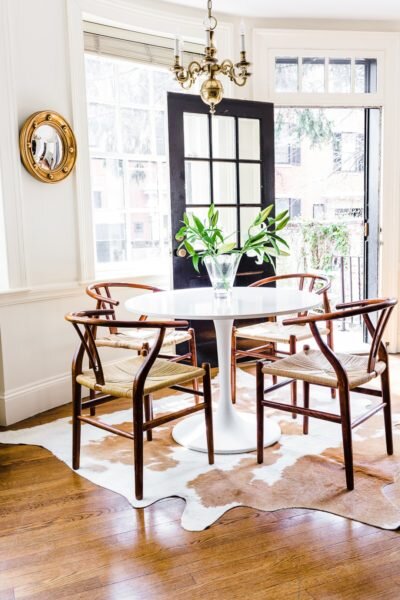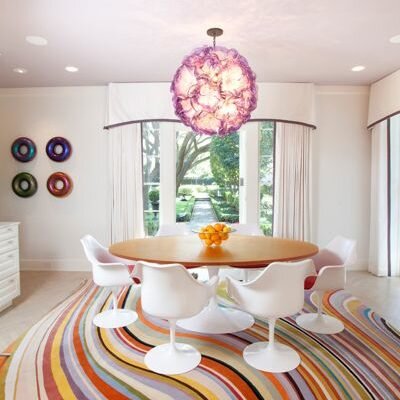The 12 Most Iconic & Popular Mid-century Chairs
The 12 most iconic and popular mid-century chairs were designed during the golden age of the 20th century, when technological innovations and the upward mobility of the masses drove the world’s best designers to seize the creative challenge of re-inventing a lowly piece of furniture. Thank God, great minds are still at it, and a wide range of inspired and inspiring designs have resulted.
My fabulous Eames recliner in my office
1. The Eames Recliner
by Charles Ormond Eames, Jr. and Bernice Alexandra “Ray” Kaiser Eames
No list would be complete without the Eames recliner. A universally recognized form, the Eames Lounge Chair and Ottoman have their origin in Charles and Ray’s investigations into molding plywood and a desire to improve upon a familiar fixture in many living rooms: the lounge chair. Citing the English club chair as inspiration, Charles said he sought to design a modern version of that chair, one that had “the warm receptive look of a well-used first baseman’s mitt.”
Almost immediately, the design became an icon of American design. Today, these pieces not only live in museums, but continue to offer comfort and style to interiors everywhere. A universally recognized form, the set is available in a variety of veneers, multiple upholstery options—including a choice of leathers or Mohair—and two sizes. Whatever selection you make, you can be assured of the quality and authenticity of this design.
Twin Egg Chairs in leather
2. The Egg Chair
by Arne Jacobsen
The eye-catching work of the Danish architect and designer Arne Jacobsen often introduces new collectors to mid-20th century furniture. With their fluid lines and sculptural presence, Jacobsen’s signature pieces — the elegant “Swan chair” and the cozy-yet-cutting edge “Egg chair,” both first presented in 1958 — are iconic representations of both the striking aesthetic of the designers of the era and their accompanying attention to practicality and comfort.
Jacobsen designed furniture that had both gravitas and groove. Though Jacobsen is a paragon of Danish modernism, his approach to design was the least “Danish” of those who are counted as his peers. The designs of Hans Wegner, Finn Juhl, Børge Mogensen, and others grew out of their studies as cabinetmakers.
Modern Office with Barcelona chairs
3. The Barcelona Chair
by Ludwig Mies van der Rohe and Lilly Reich
This beauty was designed by Mies van der Rohe and his close colleague Lilly Reich. And what a beauty it is. The chair was originally designed for the German Pavilion at the International Exposition of 1929 in Barcelona.
Seen from the side, the single curve of the bar forming the chair’s back and front legs crosses the S-curve of the bar forming the seat and back legs, making an intersection of the two. This simple shape derives from a long history of precedents, from ancient Egyptian folding stools to nineteenth-century neoclassical seating. The cantilevered seat and the back of the original chairs were upholstered in white kid leather with welt and button details.
Several lovely Wishbone Chairs, ready for dinner
4. The Wishbone Chair
by Hans Wegner
Hans Wegner was a Danish furniture designer of the mid-century school of Organic Functionality. This seat, inspired by a portrait of a Danish merchant in a Chinese Ming chair, was one of three he designed for Carl Hansen & Søn in 1949, which combined the top rails and arms into one piece.The characteristic Y-shaped back provides comfortable support while giving stability to the steam-bent top. Cutting-edge when it was first produced, many view the Wishbone as an ideal chair, as it fulfills the functional demands for comfort and stability while having a distinct look. In other words: it captures the essence of modern Danish design.
Featured in many movies, the Ball Chair personifies the 1960s
5. The Ball Chair
by Eero Aarnio
The Ball Chair was designed in 1963 and debuted at the Cologne Furniture Fair in 1966. The chair is one of the most famous and beloved classics of Finnish design and it was the international breakthrough of Eero Aarnio. The Ball Chair can be found in the collections of design museums around the world, and it has starred in several movies, music videos, and magazine covers. When Eero Aarnio moved into his first house back in 1962, he had no proper armchair, so he decided to make one. While sketching possible designs, he noticed the simplest resembled a ball. So he sat in a chair and had his wife draw the course of his head on the wall, which is how he determined the height and width of the chair, as he was taller than his wife. A true DIYer, he fashioned the first prototype using the same molding technique used to create glider fuselages.
The Ball Chair is often used in films to evoke the futuristic Mod style of the 1960s, or to suggest the villainy of a person who sits shadowed within its depths.
Suspended in air, the Bubble Chair evokes a floating or bubble-like sensation
6. The Bubble Chair
by Eero Aarnio
After the success of his Ball chair, Aarnio took the notion of hemispheric seating once step further by designing a chair out of transparent molded acrylic, which was a high-tech material back in 1968. The result was a futuristic seat appropriate for swingers of all eras. It is made of acrylic on steel frame and has leather cushions, and distributed by Aarnio Originals. The chair is suspended from above leading to a floating or bubble-like sensation. It is considered an industrial design classic and advanced the usage of plastics in furniture design. The chair is considered modernist or spaceage and is often used to symbolise the 1960s period.
A Womb chair, perfect for lounging
7. The Womb Chair
by Eero Saarinen
Eero Saarinen designed the groundbreaking Womb Chair at Florence Knoll’s request for “a chair that was like a basket full of pillows – something she could really curl up in.” This mid-century classic supports countless positions and offers a comforting oasis of calm—hence the name.
The chair displays the Finnish-born designer’s flair for challenging rules, breaking molds and setting new standards for comfortable modern design. With its polished chrome base and a frame upholstered in fabric over a fiberglass shell, the Womb chair is designed to facilitate a relaxed sitting posture, providing emotional comfort and a sense of security – hence the name “Womb.” One of the most celebrated modern furniture designs, the Saarinen Womb chair is truly a chair you can curl up in.
The Tulip Armchair, which resembles the flower but also a stemmed wineglass
8. The Tulip Chair
by Eero Saarinen
Saarinen was among the mid-century modernists who thought the postwar world was ugly, confusing, and unrestful. He conceived the Pedestal Collection in 1957 as an elegant antidote. Is there anything more ideally serene than the Tulip chair? Saarinen said: “The undercarriage of chairs and tables in a typical interior makes an ugly, confusing, unrestful world. I wanted to clear up the slum of legs. I wanted to make the chair all one thing again.”
Arne Jacobsen’s work merits a place in any modern design collection.
9. The Swan Chair
by Arne Jacobsen
Before the Swan Chair (1958), Arne Jacobsen’s architecture and designs were shaped by an assumption of materials’ natural ways of resisting. In other words, he could make them go only so far in becoming the structures he desired. With new technologies, however, the old rules no longer applied, and he was able to shape fluid curves and single-piece molded shells. The Swan Chair is now made from polyurethane foam, but at the time, Jacobsen used Styropore® to create its continuous shape. Designed for the SAS Royal Hotel in Copenhagen, for which Jacobsen was the architect, the chair permitted guests to spin on its swivel base, thus becoming active participants in the busy hotel atmosphere. A single upholsterer hand-sews the fabric onto the frame of Swan. Original design and licensed manufacture by Republic of Fritz Hansen. Made in Poland.
“They are mainly made of air, like sculpture. Space passes right through them.”
10. The Diamond Chair
by Harry Bertoia
The Diamond Chair is an astounding study in space, form, and function by one of the master sculptors of the last century. Like Saarinen and Mies, Bertoia found sublime grace in an industrial material, elevating it beyond its normal utility into a work of art. Harry Bertoia’s wire chairs are among the most recognized achievements of mid-century modern design and a proud part of the Knoll heritage.
LC2 and LC3 were referred to as “cushion baskets”. They designed as a modernist response to the traditional club chair.
11. LC2 and LC3
by Le Corbusier, Pierre Jeanneret and Charlotte Perriand
The Le Corbusier group referred to their LC2 and LC3 Collections (1928) as “cushion baskets,” which they designed as a modernist response to the traditional club chair. These pieces reverse the standard structures of sofas and chairs by having frames that are externalized. With thick, resilient pillows resting within the steel frames, the idea was to offer all the comfort of a padded surface while applying the elegant minimalism and industrial rationale of the International Style. The resulting aesthetic of the simple tubular structure is remarkably relevant to how we live today, almost 90 years later.
It was originally known as the “resting machine.” At the time, it was nothing short of revolutionary.
12. LC4
by Le Corbusier, Pierre Jeanneret and Charlotte Perriand
Designed in 1928 this chair became famous in 1965 with Cassina, the LC4 is the definitive chaise longue: built in a shape designed for relaxation, the chair was created when the three designers teamed together to put man at the centre of their design, taking the idea that form and function should be at the service of relaxation, creating a perfect balance between its geometric purity and its ergonomic intent. The stability of the frame – for any angle of inclination – is guaranteed by the friction through rubber tubes that cover the cross bar of the base. Very good condition, almost new! The pony-skin is in perfect condition.












